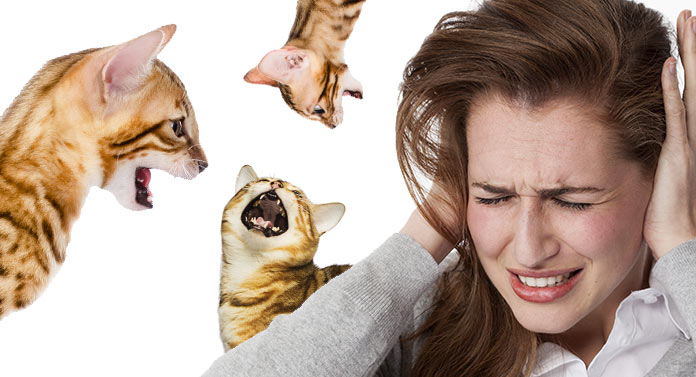
Owners of very vocal Bengal cats often end up asking how to make a Bengal cat stop meowing.
Bengals meow specifically to communicate with their human family.
It is possible to discourage a Bengal cat from meowing as much by adapting their environment, their lifestyle, and the way you react to it.
How To Make A Bengal Cat Stop Meowing
Beautiful and bold, the Bengal is a relatively new addition to our family of domestic felines.
Large and muscular with a thick, soft spotted or marble patterned coat, it’s no surprise that cat lovers yearned to own one when they first came on the scene in the early 1980s.
The first few generations were fairly shy creatures who found it difficult to adapt to our domestic settings. Which is no surprise given they are part wild Asian leopard cat.
However, as time has gone on, their descendents have become friendly, playful and very active additions to our homes.
Not only do they have beauty, but they also have brains. They are both clever and sensitive.
And whilst this means they can be lots of fun to have around, their intelligence can also give rise to behaviors that are less popular.
One of these is a tendency to over-vocalize.
The Bengal Cat Meow
This would be fine if they had a nice, pretty meow. But most Bengals have quite a harsh and demanding cry.
As the owner of a Siamese with a relentless enthusiasm for using his voice, I can testify to this behavior sometimes being a bit wearing, as much as I love him!

Interestingly the meow is a vocalization that isn’t used between cats, other than in interactions between a mom cat and her kittens.
Our clever cats have cultivated their meow specifically to communicate with people.
Of course, having a conversation with your cat is one of life’s great joys.
However, meowing can become disruptive when it’s constant, repetitive and extremely loud.
Not only will it affect you, but if your neighbours are within ear-shot you might worry about it disturbing them too.
I’ve seen cases where it has become so severe that it has affected an owner’s relationship with their cat.
Why Is My Bengal Cat Constantly Meowing?
Apart from them being pre-disposed to this behavior as a consequence of their breed, there are other reasons why some Bengals meow all the time.
Lack of stimulation
Boredom and frustration play a major role.
Although breeders often recommend that Bengals make ideal house cats, the reality, in many cases, couldn’t be further from the truth.
A Bengal’s natural instinct is to explore, hunt and establish territory.
They often roam further than regular house cats and exhibit intense territoriality.
If their ability to perform this activity is curtailed, they can become frustrated.
And shrill, repetitive vocalization may well be one of the consequences.
Their meowing has been reinforced in the past
As an intelligent and active breed, if Bengals don’t receive the stimulation they require from their environment, they may seek it from their owners using their intrusive meow.
And if you consistently verbally acknowledge it, they will know that their strategy to attract your attention has worked, and will continue to use it.
Unfortunately, this isn’t always in the best interests of either owner or cat.
You’re not always going to be in a position to be able to give your cat the degree of focus he demands. And unacceptable or inappropriate behavior can result.
So, what can you do to make your Bengal cat stop meowing?
How To Stop A Bengal Cat Meowing All The Time
The answer lies in creating an enriching and stimulating environment. And just as importantly, in changing the way you interact with him.
Firstly, it’s crucial that you remove the triggers that cause your Bengal cat to become frustrated.
One of these is not having predictable access to food.
Establishing good feeding habits
Wanting food or treats is usually the main reason why cats meow, so providing regular meals will reduce any frustration related to hunger.
This can be done by dividing your cat’s current daily allowance of food into smaller, more frequent meals.
If your cat is fed a dry diet, leaving this down for him to graze on throughout the day and night is ideal.
You can make this extra fun and challenging by placing the biscuits into interactive puzzle feeders which give your intelligent Bengal the opportunity to figure out how to retrieve the food.
There are plenty of puzzle feeders available in stores and online, or you can make your own using items such as cardboard egg boxes, paper bags or the tubes from toilet rolls.
Make treats count too!
I’m a big believer in cats having to earn their treats, and getting your Bengal cat to forage for them provides lots of fun and stimulation.
Simply hide his treats around your home inside paper bags, cardboard egg boxes, yoghurt cartons, cardboard tubes or loosely wrapped in baking paper.
It’s important that these hidden food treats are counted as part of your cat’s daily calorie intake.
Make time to play
Bengal cats are super active and need to work out!
So, playing with your cat, especially with toys that he can chase and jump up at, allows him to perform instinctive and natural hunting-like behaviors. Whilst providing necessary exercise at the same time.
It’s also a wonderful stress buster.
Giving him the opportunity to play on his own is also important.
Toys enriched with the scent of catnip, valerian, silvervine and honeysuckle are popular.
However, you might find that your cat plays with toys once then discards them.
How to keep toys ‘fresh’
The reason for this is that the toys represent prey, and once he’s killed them, they’re literally dead to him.
So, it’s a good idea to keep them all locked away in a sealed bag containing fresh catnip and valerian and bring them out randomly, one by one, to maintain their novelty.
On days when you’re not at home you can leave out cardboard boxes and paper bags (handles removed) for him to explore, making sure there is something inside for him to find such as a toy, biscuit or pinch of catnip.
Try training!
As highly intelligent cats, Bengals can be very receptive to clicker training.
So, if you really want to challenge him, there are plenty of videos available online showing you how.
The sky is the limit
All cats love to be up high and most Bengal cats are particularly adept at climbing.
Multi-level cat activity centres make great high perches, especially when placed in front of a window.
And if you want to go one step further, you could arrange floating shelves on your walls to fulfill his need for height.
Fresh air and exercise
If possible, giving your Bengal access to the great outdoors will help to fulfil his emotional and physical requirements.
Even if it’s in an enclosure or small secured yard or garden.
However, this option isn’t available to everyone, and in these cases I can’t overstate the importance of optimizing the indoor environment.
Changing Your Behavior To Make A Bengal Cat Stop Meowing
Finally, it’s time to take a look at how you interact with your Bengal cat.
Our idea of positive interactions is usually based around touching our cats, talking to them and acceding to their vocal demands.
However, we’ve already established that this is not only likely to make them continue meowing, but in extreme cases can lead to a cat that is over-attached.
Which is not in their or your best interests.
If your Bengal cat is constantly meowing, it’s time for some tough love.
What to do
Assuming you’ve implemented the environmental strategies above, to stop your cat meowing you should ignore him for a period of approximately two weeks.
This means not acknowledging him in any way either verbally, by looking at him or touching him.
Initially his meowing may increase as he works harder to get your attention. This is called an extinction burst.
When he realises that his meowing is not linked to your attention, it should stop or reduce to an acceptable level.
I’m under no illusion about how difficult this is and how much perseverance and resolve it takes.
If progress is being made you can start daily interactive play sessions with him, and eventually you will also be able to reintroduce cuddling, stroking and talking to him.
To avoid ending up back where you started, always be the one to initiate interaction, and do it when your cat is quiet.
How To Make A Bengal Cat Stop Meowing – Summary
Bengals have beauty and brains in equal measures.
If you came to this article wondering “why is my Bengal cat constantly meowing?” then hopefully now you feel like you have an answer.
And if all the innate needs of this sophisticated breed are met then you will end up with a cat that is both beautiful in looks and in behavior.
Is your Bengal cat vocal?
What strategies have you found for keeping them busy, and quiet?
Let us know in the comments box down below!
Clare Hemington DipCAPBT is a cat behaviorist and member of the COAPE Association of Pet Behaviorists and Trainers.
More About Bengal Cats
- Black Bengal Cat Breed Traits
- What Do Bengal Cats Eat?
- Bengal Colors – 40 Ways To Look Like A Leopard!
- Snow Lynx Bengal Cat Care and Traits
- Bengal Cat Names – 200 Ideas For Naming Your Male or Female
Hi Clare I’ve been fostering a Bengal in his own house for 3 weeks as owner passed away….. he’s always been vocal but he’s had to stay indoors due to a major dental and yes he was telling me all about it! Anyway I made sure I ignored him when he started and then played a game with him to tire him out…. after 4 days he got into a routine and calmed down……. he’s so lovely and has now gone to his new home……here’s hoping he’s behaving 😉
My cat meows at everything even the wall,ceiling. I can’t get him to stop. I have anxiety pills I can give him but I do this them he’s zombified. Then I feel aweful. He meows all night long at nothing. I get out of bed and say show me what you want. He goes in circle’s. What do I do????
I’m having the same problem when mine has been in a Cattery. She’s getting stressed. I was wondering about medication to calm her down